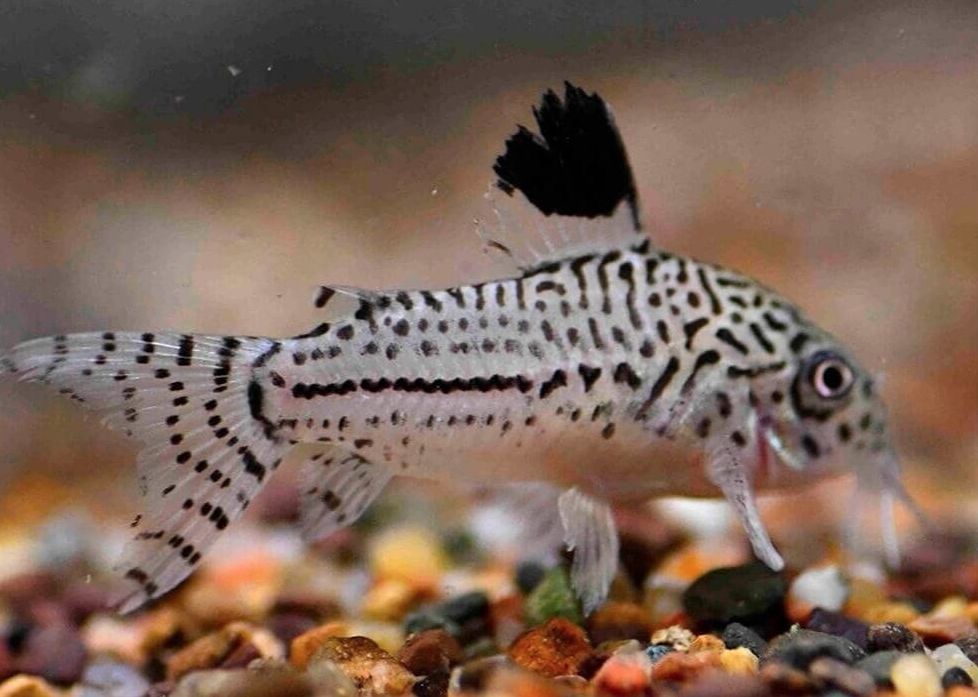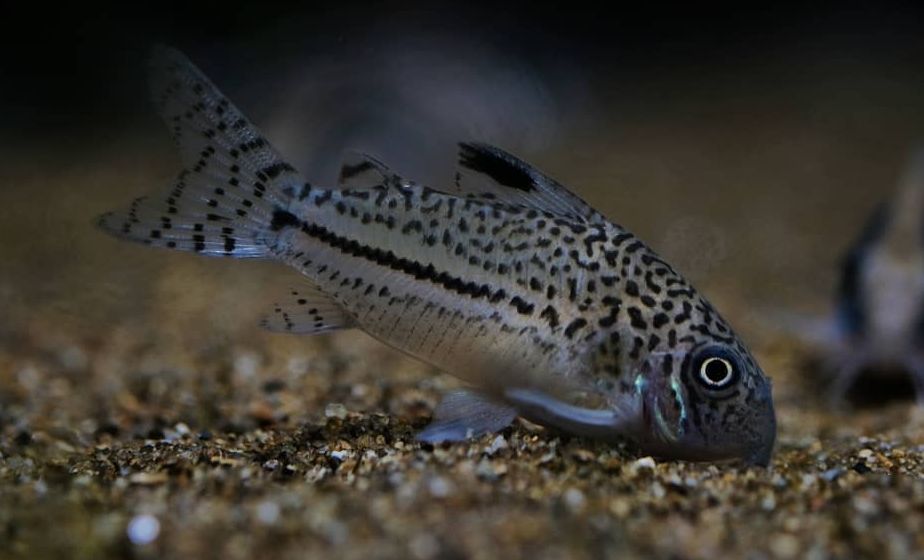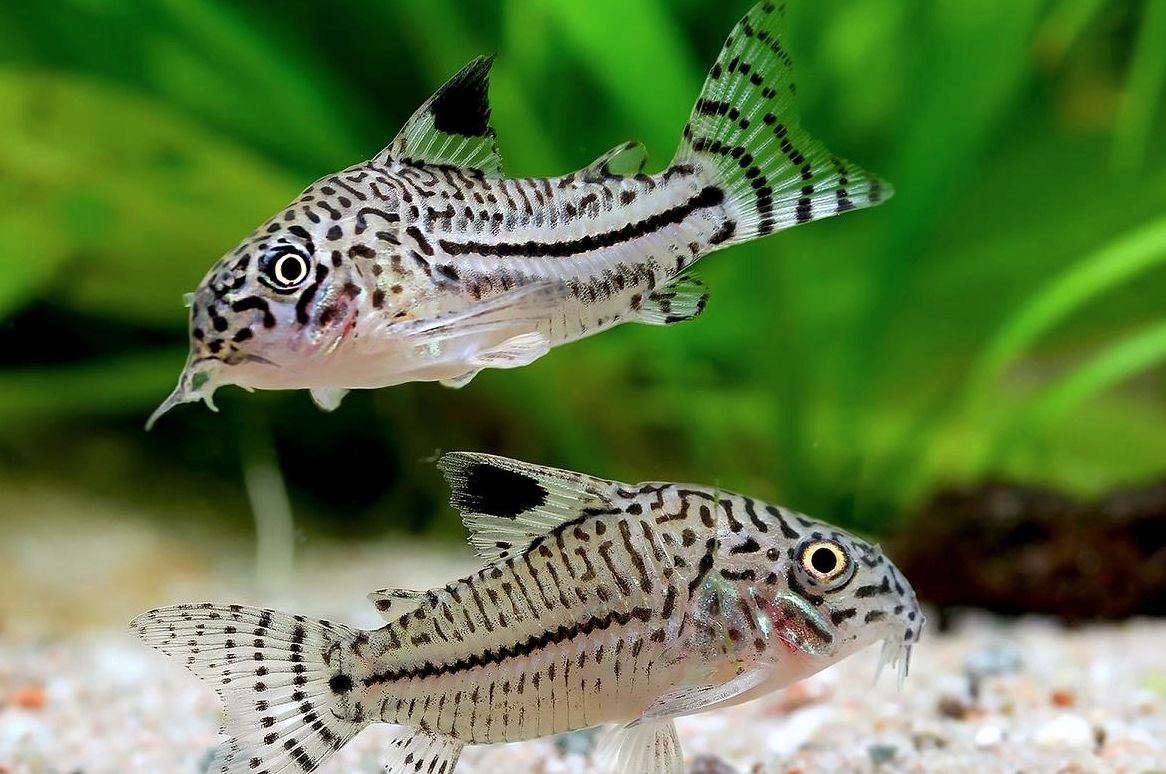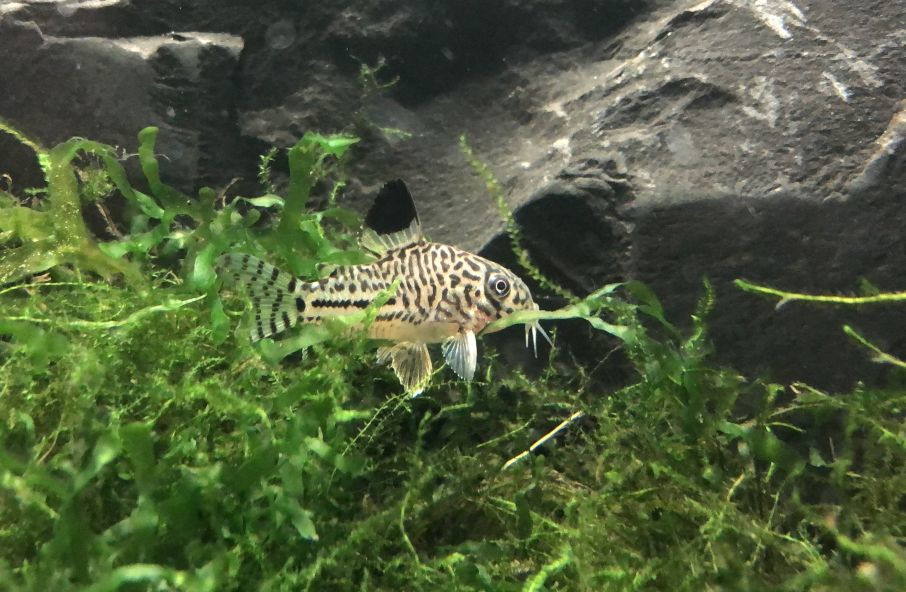Julii cory (Corydoras julii), is a typical representative of this fish kind. It is a peaceful, schooling, and omnivorous freshwater fish. This article will tell you about fish in detail – where the fish dwells, whether it is a difficult fish to keep, how to create proper tank conditions to the fish, how to select tank mates and how to breed the fish.

Contents
Habitat in the wild
Julii corydoras habitat is in North-East Brazil. The fish is endemic to coastal river systems to the South of the Amazon River estuary in the state of Piauí, Maranhão, Para, and Amapa. The fish was found in the Guama River (including its tributaries such as The Ararandeua River), Maracanã, Morcego, Parnaiba, Piriá, Kaete, Turiaçu and Mearim River. Julii cory is encountered in small rivers, tributaries, and other water basins in a rainforest.
The fish got its name from someone whose personality is actually unknown. Corydoras julii is often confused with another catfish, because the fish appearance is quite similar to another kind – Corydoras trilineatus. This fish kind dwells on the upper course of the Amazon River, and it is less demanding.
Since it is rather popular and demanded fish, even those who are selling them can’t say for sure what kind of fish they are selling. Nevertheless, it is possible to see between these two fish kinds. Julii cory has one clear stipe on the side of its body, while C. trilineatus has several stripes, and they are brighter and more pronounced. There are more differences, but only a specialist can see them.

Description
The julii cory, scientifically known as Corydoras julii, belongs to the family Callichthyidae. This family is commonly referred to as the armored catfish family. It includes various species of small to medium-sized catfish that are primarily found in South America.
The Callichthyidae family is known for its unique characteristics, such as the presence of bony plates or scutes that cover their bodies, giving them a protective armor-like appearance. These plates serve as a defense mechanism against potential predators.
It is one of the most appealing Corydoras species due to its bright coloring. The fish body is white-gray close to ivory white with small back spots and undulated lines scattered over it.
Along the lateral line, the spots form a black line that stretches to the fish tail. Dorsal fin finishes in a black spot, while the caudal fin has vertical black stripes on it. There are no spots on the fish abdomen, and its color is light. The fish has three pairs of barbs near its mouth.
Size
How big do julii cory catfish get?
Julii Cory catfish (Corydoras julii) are relatively small fish compared to some other catfish species. On average, they reach a size of about 2 to 2.5 inches (5 to 6 cm) in length.
Lifespan
How long do julii cory live?
Corydoras julii have an average lifespan of around 5 to 8 years in captivity when provided with proper care and a suitable environment. However, it’s important to note that individual lifespan can vary depending on factors such as genetics, diet, water quality, tank conditions, and overall health.
| Characteristic | Description |
|---|---|
| Scientific Name | Corydoras julii |
| Common Names | Julii Cory, Julii Corydoras, julii catfish |
| Adult Size | Around 2-2.5 inches (5-6 cm) |
| Lifespan | 5-8 years |
| Appearance | Light beige to pale yellow body with black spots or blotches |
| Body Shape | Slender and elongated with an arched back |
| Habitat | Slow-moving rivers, streams, and flooded areas in South America |
| Temperament | Peaceful and sociable |
| Water Temperature | 72-79°F (22-26°C) |
| pH Level | 6.0-7.5 |
| Water Hardness | 2-12 dGH |
| Diet | Omnivorous, primarily eats small invertebrates and algae |
| Tank Size | At least 20 gallons (75 liters) for a small group |
| Tank Setup | Sandy or fine-grained substrate, plants, hiding spots, and driftwood |
| Compatible Tank Mates | Peaceful small fish such as tetras, rasboras, and dwarf cichlids |
| Breeding Difficulty | Moderate |

Difficulties in keeping
This is a peaceful, schooling and relatively undemanding fish. However, I’d recommend beginner aquarists to try keeping some less demanding species, for example, adolfo’s catfish or panda cory.
Care and Keeping in a tank
Tank size
Like most of Corydoras species, julii is peaceful, and he will perfectly do for most community tanks. However, keep in mind that the fish should be kept only in a school. At that, the more fish you have in the school, the more comfortable they feel, and the more natural behavior the fish demonstrate.
Can julii corys live alone? No. The recommended minimum number of fish in the school is from 6-8 species. A tank size of at least 20 gallons (75 liters) is recommended for a small group of Julii Corys.
Having a larger tank allows for more swimming space and provides room for additional tank features such as plants, hiding spots, and driftwood. The extra space also helps maintain stable water conditions and reduces the accumulation of waste.
Additionally, a larger tank size can accommodate a small group of Julii Corys, as they are social fish and thrive when kept in groups of five or more. A larger group helps create a more natural social dynamic and promotes their well-being.
Water parameters
Here are the recommended water parameters for Julii Corys:
- Temperature: Julii Corys prefer a temperature range of 72-79°F (22-26°C).
- pH Level: Julii Corys thrive in slightly acidic to neutral water. Aim for a pH level between 6.0 and 7.5. Keeping the pH within this range helps maintain their natural habitat conditions.
- Water Hardness: Julii Corys can tolerate a moderate range of water hardness. Aim for a hardness level between 2-12 dGH (degrees of general hardness). This range provides a suitable mineral balance for their well-being.
- Ammonia, Nitrite, and Nitrate Levels: Regularly test the water parameters for ammonia, nitrite, and nitrate levels to ensure they remain within safe limits. Ammonia and nitrite should be kept at zero, while nitrate levels should be kept as low as possible (below 20-30 ppm) through regular water changes and maintenance.
- Filtration and Water Flow: Julii Corys prefer moderate water flow. Make sure the aquarium is equipped with a gentle filter or use a spray bar to disperse the flow. Avoid strong currents that may stress the fish.
Substrate
One of the key requirements to create comfortable tank conditions for the fish is to have a non abrasive sand substrate, or it can be from small-sized pebbles. In the wild, fish constantly digs the bottom while looking for insects and their larvae. The fish uses its sensitive barbs to find them, and if the tank bottom consists of large-sized or sharp pebbles, the fish can damage its barbs.
Small or medium-grained sand will be perfect as a tank bottom substrate, but small pebbles or basalt will do as well.
Decor
Remember to consider the tank dimensions and provide appropriate substrate, plants, and hiding spots to create a suitable environment for the Julii Corys. Providing enough horizontal and vertical swimming space will allow them to explore, forage, and exhibit their natural behaviors.
Although the fish doesn’t need tank plants to feel comfortable, however, if there are some in the tank, they will make it look nicer and also create some shelters for the fish.
Besides, you can use some snags and fallen leaves together with the tank plants to make your aquarium look more natural, since these are the conditions that fish has in the wild. The corydoras julii prefer moderate water flow and clean tank water. It’s desirable to use an external filter, but for small-sized tanks, internal ones will do as well.

Diet
All Corydoras kinds are omnivorous, and they are bottom feeders. In most cases, they easily eat some drowning food (especially the one made for catfish), live and frozen food (they like tubifex), plant food pellets. Diversified diet is the main thing for the fish to stay healthy and grow large. There is no way you can consider julii a picker and hope that the fish will only feed on what its tank mates haven’t eaten.
This fish requires a nutritious diet. You should make sure that it gets enough food, especially if many fish species dwell in medium water layers in your tank. Choose high-quality sinking pellets or flakes specifically designed for bottom-dwelling catfish. Look for products that provide a balanced nutritional profile and are formulated to meet the dietary needs of catfish species.
Tank mates
Corydoras julii is a perfect match for most small-sized catfish and other fish kinds. Possible tank mates are zebra danio, apistogramma Ramirezi, betta, shrimps (Amano shrimp, cherry shrimp) and even angelfish. You should only avoid keeping large and aggressive fish kinds (like oscar fish, green terror cichlid, jaguar cichlid, flowerhorn fish).
Corydoras julii are generally peaceful and can coexist with a variety of other peaceful fish species in a community aquarium. Here are some popular tank mates that can be suitable companions for Corydoras julii:
- Harlequin Rasboras (Trigonostigma heteromorpha)
- Neon Tetras (Paracheirodon innesi)
- Ember Tetras (Hyphessobrycon amandae)
- Glowlight Tetras (Hemigrammus erythrozonus)
- Black Neon Tetras (Hyphessobrycon herbertaxelrodi)
- Cardinal Tetras (Paracheirodon axelrodi)
- Rummy Nose Tetras (Hemigrammus rhodostomus)
- Dwarf Gouramis (Trichogaster lalius or Trichogaster chuna)
- Sparkling Gouramis (Trichopsis pumila)
- Celestial Pearl Danios (Danio margaritatus)
- White Cloud Mountain Minnows (Tanichthys albonubes)
- Dwarf Rasboras (Boraras spp.)
- Endler’s Livebearers (Poecilia wingei)
- Guppies (Poecilia reticulata)
- Platies (Xiphophorus spp.)
- Corydoras Catfish (Corydoras spp. – pygmy cory, panda cory, adolfoi catfish)
- Otocinclus Catfish (Otocinclus spp.)
- Bristlenose Plecos (Ancistrus spp.)

Gender differences: male vs female
Distinguishing between male and female julii cory catfish can be a bit challenging as they do not exhibit significant external differences. However, there are a few subtle characteristics that can sometimes help differentiate between the sexes:
- Size: In some cases, mature female may appear slightly larger and broader-bodied than males. However, this size difference is not always easily noticeable and can vary between individuals.
- Abdominal Shape: Females may have a slightly rounder and fuller abdomen, especially when they are carrying eggs. This can sometimes be observed as a bulge on the lower part of the body, near the ventral fins. However, this characteristic is more apparent when the females are ready to breed.
- Vent Position: Another potential method to differentiate males from females is by examining the vent area. In mature males, the genital papilla (a small, pointed extension) is often more pronounced and visible, while in females, the area is typically smoother and less prominent.
- Behavioral Cues: During breeding activities, males may exhibit more intense and frequent chasing or courting behaviors towards females. However, these behaviors alone may not be reliable for sex determination.
In community aquarium settings, it is common to keep a small group of Julii Corys rather than focusing on specific male-female ratios. Keeping a group of five or more individuals ensures social interaction and reduces the likelihood of individuals feeling stressed or singled out.
Breeding
Breeding is similar to that of most Corydoras species. You should put two-three julii cory males and one female in a spawning tank. When the female fish becomes fat with eggs, you should perform significant water renew with 50-70% of colder water and increase aeration and water flow in the tank.
If the fish doesn’t start spawning, repeat the procedure. The female fish lays eggs on tank plants and tank glass, and then the male fish fertilizes them. It is recommended to use caprone threads, since you can easily collect them after the spawning is over and remove the eggs to another tank.
You should remove the breeders from the tank after the spawning and move the eggs to another tank. The water parameters in this tank should be similar to those in the spawning tank.
Most of the aquarists add a few drops of methylene blue into the tank water to disinfect it and prevent fungal infection. The incubation period lasts for 3-4 days, and once the larvae eat all its yolk bag, the juveniles start to swim. You can feed juveniles with Vinegar eels, brine shrimp nauplii, and artificial food.
The julii cory juveniles require crystal clean water, and they are less prone to various illnesses if you put a thin layer of sand on the tank bottom.